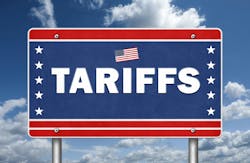How Supply Chains Can Adjust to New Tariffs
As new tariffs take effect today, Deloitte offers an analysis of what this could mean to the US economy in its report, Prioritizing Supply Chain Resilience and Agility: Strategies for US Manufacturing in a New Era of Industrial Policy, released on April 1.
The authors offer the following analysis: (excerpted below)
President Trump’s policy priorities include cutting taxes, reducing regulations, lowering energy costs, and bolstering fair trade. These measures could collectively support—and potentially accelerate—continued investment in the US manufacturing sector, a major goal of the Trump administration.
The administration’s policies could also potentially drive a notable shift in supply chain strategy by prioritizing reshoring while potentially disrupting recent nearshoring and global sourcing trends.
Tariffs comprise a component of President Trump’s economic strategy, with stated aims of boosting US manufacturing, collecting tariff revenue, addressing unfair trade, and strengthening national security. For instance, invoking the International Emergency Economic Powers Act, the President has imposed 25% “supplemental tariffs on imports from Mexico and Canada (with the exception of a 10% tariff on Canadian energy resources), and 20% tariffs on all goods from China.
He later amended the tariffs on Mexico and Canada to temporarily exclude goods that comply with the United States-Mexico-Canada free trade agreement (USMCA) and levied 25% tariffs on all aluminum and steel imports.
President Trump has also signed several trade-related executive orders such as the “America First Trade Policy.” This policy directs various federal agencies to investigate the impact of international trade dynamics on US workers and businesses as well as the USMCA, which could result in new tariffs or other changes to trade policy in the future.
This shift in policy approach and the potential for ongoing supply chain volatility could present opportunities and challenges for US manufacturers due to factors such as the geographic location of their supply base, the size and financial health of the company, and their ability to flexibly respond to supply chain shocks.
If steps are not taken to build resilience and agility, some companies—including smaller firms that make up a significant portion of the US manufacturing landscape1may struggle to absorb added costs, which could lead to reduced business or even closures. Conversely, a company with an international production footprint could instead shift production to its established US manufacturing facilities and potentially gain market share from competitors.
The report offers some advice on what supply chains can do in these circumstances: (excerpted below)
#1: Assess supply chain exposure and risk
A step US manufacturers could take is to perform a detailed analysis to determine the potential impacts of tariffs and any trade tensions on its supply chain. This includes scenario planning for direct tariff impacts as well as potential retaliatory actions that other countries could levy on US exports. It should also include understanding “second order risks” from suppliers (including tier 1, tier 2, and beyond) that source inputs from abroad and may need to raise prices or might face financial distress that could lead to disruptions. Here are a few steps for US manufacturers to consider taking throughout their supply chains.
- Map your exposure. Analyze import transaction data and determine the country of origin for all components and raw materials that are sourced from outside the United States. Verify that imported components are classified under the correct HTS Code and determine if tariffs apply to those components.
- Assess the likelihood of ongoing trade tensions. Supplemental tariffs can be levied even on countries within free trade agreements like the USMCA.
- Estimate added costs for various tariff scenarios. By considering the country of origin and the potential for trade tensions, US manufacturers can gain insights into potential tariff scenarios. Early identification of components and products with higher volumes and values that may be subject to tariffs can help prioritize and focus mitigation strategies.
#2: Consider near-term tariff mitigation approaches
Before making substantial changes to their supply chains, manufacturers can take steps to help mitigate the impact of tariffs on their bottom line. These approaches may be particularly prudent if supplemental tariffs are levied temporarily and later removed.
Some US companies “front-load” imports by stocking up before tariffs are imposed. Although the benefits are temporary, several companies used this strategy ahead of tariffs levied on China in 2018 and again in late 2024. Another strategy is to collaborate with partners to renegotiate contracts based on current market conditions. Although the importer of record is legally required to pay tariffs, manufacturers can work with their suppliers to offset the cost of the tariff. If the existing contract has a “change in law” clause, that may allow for revisions to terms, including pricing.
There are also duty-reduction strategies that companies can investigate to help manage the financial impact of tariffs. These can include applying for exemptions and exclusions, if available; implementing available customs valuation planning strategies such as unbundling non-dutiable elements from the price of imports; evaluating transfer pricing strategies; and assessing first sale for export customs valuation structures. Supply chains may allow companies to take advantage of foreign trade zones or bonded warehouses, while moving production to or sourcing from another country (discussed next) can change the country of origin and potentially reduce the duty.
#3: Explore supply chain strategies to help minimize cost and emphasize resilience
After considering near-term tariff mitigation approaches manufacturers may need to evaluate their overall supply chain strategy and decide which products and intermediate inputs they should manufacture domestically versus in other countries. In addition to tariffs and trade policy, several factors can play an important role in this decision.
Read the extensive analysis offered in the report.
